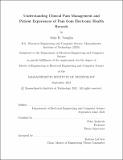Understanding Clinical Pain Management and Patient Experiences of Pain from Electronic Health Records
Author(s)
Vaughn, Julie R.
DownloadThesis PDF (3.127Mb)
Advisor
Szolovits, Peter
Terms of use
Metadata
Show full item recordAbstract
Opioid prescription practices in clinical settings are frequently variable and subjective. Improper usage of prescription opioids is in turn a massive public health issue in the United States. However, lack of pain medication can also lead to patients being unable to perform daily activities due to unmitigated pain. In this thesis, we find that data on opioid prescriptions and self-reported pain reveal differences in how patients of different demographics report pain and in how providers choose to prescribe opioids. We analyze data from two distinct populations, the MIMIC III ICU dataset and records from general medical services at Brigham and Women’s Hospital (BWH). This work is undertaken in collaboration with providers at BWH in Boston. To help quantify and standardize patients’ experiences of pain, we may consider the concept of functional pain — i.e., if the patient is in too much pain to perform basic activities such as turning or walking. This gives rise to the clinical Functional Pain Scale (FPS), which we will endeavor to use retrospectively with clinical notes. We identify and isolate relevant notes and annotate them for relevant spans, and assign an overall functional pain score to each note based on BWH guidelines. Natural Language Processing (NLP) models are then trained to identify these spans and to predict the assigned functional pain score. Through this work, we hope to improve pain management practices, and more broadly, the patient experience.
Date issued
2021-09Department
Massachusetts Institute of Technology. Department of Electrical Engineering and Computer SciencePublisher
Massachusetts Institute of Technology